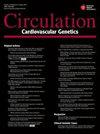猝死心律失常死亡综合征的遗传保险歧视:来自北美横断面调查的经验证据。
Q Medicine
引用次数: 17
摘要
背景:目前几乎没有关于突发性心律失常死亡综合征(SADS)家族史可保性的信息来确定遗传筛查的非临床意义。重要的是要确定家庭因SADS基因筛查而面临的障碍和挑战,以便公平获得保险覆盖。方法与结果为探讨受sads影响家庭的保险投保经历,我们于2012年4月28日至2013年11月13日在北美地区进行了一项横断面在线调查。参与者包括被诊断为SADS的个人及其已申请保险(健康、生活、旅行和残疾)或已有保险的亲属。在202名参与者中,92%(92%)的先证者(50%)或受影响的亲属(42%)被诊断为SADS;8%的参与者是先证者的未受影响的家庭成员;73%的人报告了基因证实。54%的SADS受访者申请保险,60%被保险公司拒绝。先前存在的SADS诊断是报告排斥反应的主要原因(57%)。大多数受访者(80%)在诊断时通过配偶/父母计划获得保险;14%的人随后经历了覆盖率的负面影响。39%受影响的SADS受访者表示,保险费率有所增加。结论基因检测的增加对SADS患者及其家属的可保性产生了负面影响。在获得人寿和健康保险方面面临的挑战主要是由于先前存在的状况,即使在美国有保护法律。本文章由计算机程序翻译,如有差异,请以英文原文为准。
Genetic Insurance Discrimination in Sudden Arrhythmia Death Syndromes: Empirical Evidence From a Cross-Sectional Survey in North America.
BACKGROUND
There is virtually no information assessing the insurability of families affected with Sudden Arrhythmia Death Syndromes (SADS) for the determination of the nonclinical implications of genetic screening. It is important to identify the barriers and challenges faced by families as a result of genetic screening for SADS to enable equitable access to insurance coverage.
METHODS AND RESULTS
To explore the insurance coverage experiences of SADS-affected families, we administered a cross-sectional online survey across North America from April 28, 2012 to November 13, 2013. Participants included individuals with a SADS diagnosis and their relatives who have applied for insurance (health, life, travel, and disability) or have existing insurance coverage. Of 202 participants, 92% had a SADS diagnosis (92%) as either a proband (50%) or an affected relative (42%); 8% of participants were unaffected family members of a proband; and genetic confirmation was reported by 73%. Of the 54% of SADS respondents who applied for insurance, 60% were rejected by insurers. The preexisting SADS diagnosis was the major reason reported for rejection (57%). Most respondents (80%) had insurance coverage through a spouse/parent plan at the time of diagnosis; 14% experienced a subsequent negative effect on coverage. Thirty-nine percent of affected SADS respondents reported an increase in insurance premium rates.
CONCLUSIONS
Increased genetic testing has negatively impacted insurability for SADS patients and affected family members. The challenges in obtaining life and health insurance are mainly because of the preexisting condition, even in the presence of protective laws in the United States.
求助全文
通过发布文献求助,成功后即可免费获取论文全文。
去求助
来源期刊

Circulation-Cardiovascular Genetics
CARDIAC & CARDIOVASCULAR SYSTEMS-GENETICS & HEREDITY
CiteScore
3.95
自引率
0.00%
发文量
0
期刊介绍:
Circulation: Genomic and Precision Medicine considers all types of original research articles, including studies conducted in human subjects, laboratory animals, in vitro, and in silico. Articles may include investigations of: clinical genetics as applied to the diagnosis and management of monogenic or oligogenic cardiovascular disorders; the molecular basis of complex cardiovascular disorders, including genome-wide association studies, exome and genome sequencing-based association studies, coding variant association studies, genetic linkage studies, epigenomics, transcriptomics, proteomics, metabolomics, and metagenomics; integration of electronic health record data or patient-generated data with any of the aforementioned approaches, including phenome-wide association studies, or with environmental or lifestyle factors; pharmacogenomics; regulation of gene expression; gene therapy and therapeutic genomic editing; systems biology approaches to the diagnosis and management of cardiovascular disorders; novel methods to perform any of the aforementioned studies; and novel applications of precision medicine. Above all, we seek studies with relevance to human cardiovascular biology and disease. Manuscripts are examined by the editorial staff and usually evaluated by expert reviewers assigned by the editors. Both clinical and basic articles will also be subject to statistical review, when appropriate. Provisional or final acceptance is based on originality, scientific content, and topical balance of the journal. Decisions are communicated by email, generally within six weeks. The editors will not discuss a decision about a manuscript over the phone. All rebuttals must be submitted in writing to the editorial office.
 求助内容:
求助内容: 应助结果提醒方式:
应助结果提醒方式:


